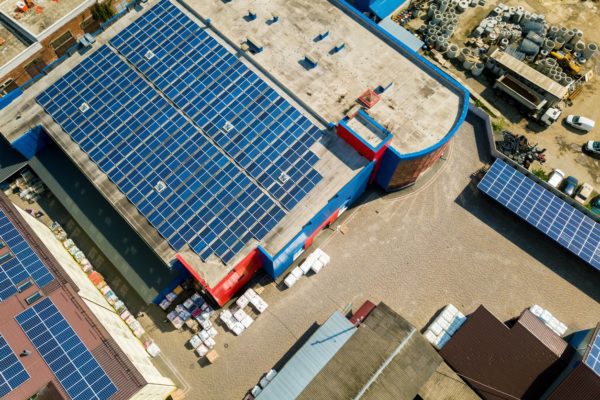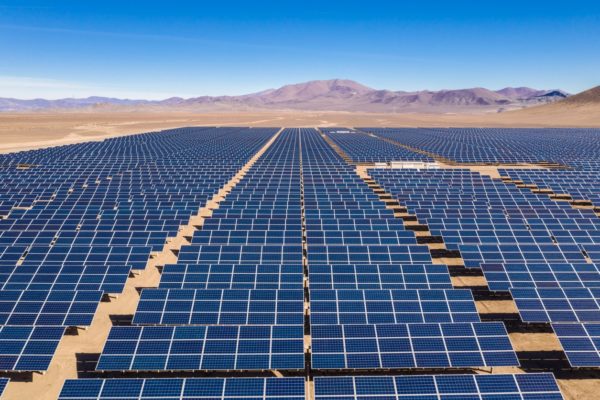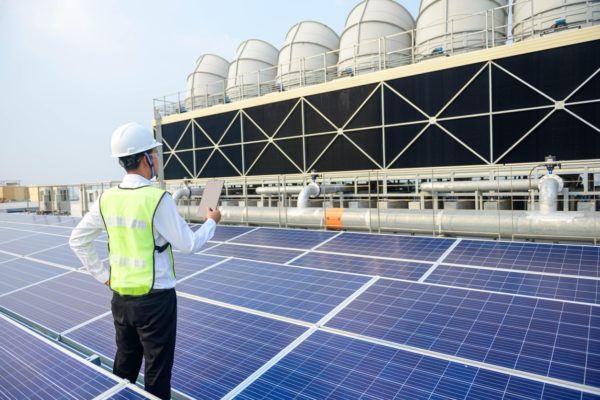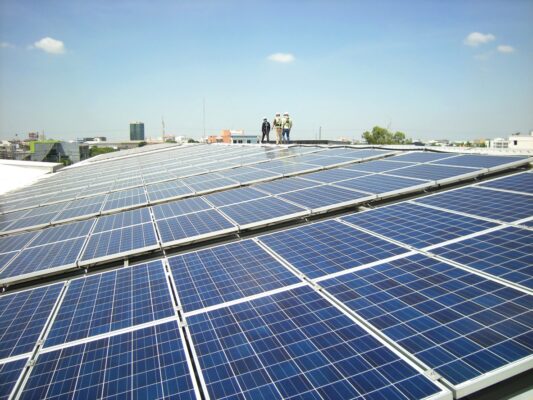
There are numerous processes involved in installing solar panels on your roof and producing sustainable energy. One of the most crucial steps in this process is obtaining permission from the grid operator to connect your home to the electric grid. The electric grid is the distribution system that links power plants with homes and buildings to provide electricity.
This article will help you understand solar interconnection so that you can understand the steps you should take before your local utility company and your commercial solar company approve your solar system to begin generating power.
What is Solar Interconnection?

Solar interconnection is a procedure where a commercial solar customer requests and receives approval from their local utility provider to connect to the electric grid. Your Coldwell Solar provider will handle this interconnection process on your behalf.
Depending on your utility company and system size, the interconnection procedure for home solar can take anywhere from two to four weeks on average.
The cost of connections may vary, depending on your utility, the size of your solar installation, and the distance of your home from the electric grid. The cost of this process is factored into the overall price of your system; however, it varies from home to home.
Process of Solar Interconnection

Solar interconnection consists of two main processes, and we will discuss them below.
- Applying for the interconnection process
- Permission to Operate (Obtaining authorization to operate)
1. Applying Interconnection
Utility providers need to verify that your solar energy system complies with necessary electrical safety requirements before they will allow it to connect to their grid. Additionally, they’ll ensure your solar power system complies with their net metering requirements.
Some of the information required by interconnection applications include your past electricity usage, information regarding your property, and the characteristics of the system you want to design, such as system size, equipment, system design, production estimates, and location of the system.
The utility account holder may file an interconnection application, although most installation companies will do so on your behalf. A utility may refuse to connect to the grid and ask for changes or a resubmission if there are any warning signs or blanks in the application.
You and your installer can continue with the installation process after receiving approval from your energy utility. After installing the solar system, the last stage of solar interconnection, i.e., permission to operate, occurs.
2. Permission to Operate (PTO)
The last stage in connecting your solar to the grid is obtaining approval to run your commercial solar panel installation once it has been placed on your property and your local authority has completed its inspection process.
In the first step of PTO, utilities may send a person to your property to inspect the system. During this visit, the utility representative usually examines the connection at the electrical panel, the system’s operation, and the inverter.
Furthermore, they often install an extra meter or may upgrade the existing one so they can monitor the solar electricity exports you make to the grid, allowing you to benefit from the incentive of the utility’s net metering.
After the inspection and meter upgrading, you will receive official PTO documentation allowing you to officially turn on your solar panel system for electricity generation.
Types of Solar Interconnection

There are two types of grid-linking techniques:
1. Line-Side Interconnections
Line-side interconnections involve attaching the solar to the utility side of your facility’s main electrical panel or switchboard. The potential array size is maximized and can provide the energy requirements of the entire building, even though utilities often have stricter regulations for line-side interconnections and may demand the replacement of equipment, such as the Current Transformer (CT) cabinet.
2. Load-Side Interconnections
Load-side interconnections are less complicated to install because they only need the addition of a breaker at the end of the electrical panel, which is typically where the switchgear or main electrical panel is located.
However, there is a restriction on array size. An electrical panel or switchgear may accommodate only a certain amount of current. We must ensure that the combined current does not exceed the panel rating because it will be provided by both the utility and the solar array.
Interconnection voltage is yet another crucial design factor. Commercial premises typically receive 208V from the utilities, whereas industrial buildings receive 480V. Most inverters with an output of 20kW or more produce 480V. Therefore, commercial buildings often need a solar transformer to reduce 480V to the interconnection voltage.
Also, the output wires must eventually be combined into one using a combiner panel if a solar array is big enough to need more than one inverter. The combiner panel will be situated on the roof whenever feasible, but it might also need to be set up somewhere else, like the facility’s electrical room.
The interconnection point must then be reached by running conductors from the roof. Leads can be run along an exterior wall. However, this may not look good, especially for a commercial building or apartment complex. Ideally, a closet or other interior space exists where leads can run out of sight.
Early in the project design process, Coldwell Solar conducts a thorough site study that involves assessing and suggesting potential sites for this installation. Our staff now offers advice for additional incidental hardware, such as over-current safety. We reduce the impact of this additional hardware requirement in the electrical room and elsewhere by focusing on equipment positioning early in the design process.
Cost of Solar Interconnection
Depending on the utility company, the area, and the size of the system, interconnection fees can range from nothing to several hundred dollars for residential solar panel systems. Since many installation companies will include the cost of connecting in the overall cost of your solar energy system, you might need to be made aware of this fee when you go solar.
Small-scale residential solar panel installations rarely call for significant grid improvements for connections, but larger commercial solar projects often go through major upgrades. The electrical grid is intended to transport electricity from centrally located power plants to residences and commercial establishments that need it. The grid handles and operates the small-scale residential installations to push electricity back onto the grid.
However, because commercial installations generate more electricity, the grid must be set up to handle additional electricity generation, which may necessitate upgrading the infrastructure of the current grid. These additional expenses can differ significantly depending on the sort of upgrade required. Fortunately, rules in many places will prevent solar customers from incurring additional charges before the utility does.
How Long Does It Take To Interconnect Solar Power?
Similar to the cost of interconnection, your utility company and system size will significantly impact how long it takes to join your solar panel system to the grid.
For installations of home solar panels, the interconnection application procedure typically takes two to three weeks. Getting permission to use the solar panel system often takes one to two weeks after installation and passing local inspection.
Because the application and grid infrastructure often need a more thorough assessment to ensure everything is up to the necessary electrical safety standards, this procedure may take longer for large commercial projects.
Importance of Solar Interconnection

For the sake of public safety, solar interconnecting procedures must be clear and well-defined. To protect people, systems, and property, utility providers must examine each and every connection to the grid.
In order to prevent solar electricity from harming utility personnel, grid-connected solar power systems are built to shut down automatically during power outages. When there is a power outage, solar power systems with battery storage are made to keep producing solar electricity to ensure that all extra production is saved in the battery rather than delivered to the grid. The term used for this process is solar islanding.
The utility can check that the safety precautions required to connect your solar power system to the grid are in place and functional during the interconnection procedure. Net metering can also be set up on your electric bill during this process.
It’s critical to realize that utility procedures and specifications are subject to change. These upgrades may be based on the grid’s ability to support additional renewable energy systems, adjustments to rules governing the use of accepted solar equipment, adjustments to utility internal procedures, or adjustments to interconnection standards at the state level.
Your solar company should hire interconnection experts who are knowledgeable about the procedures and have the expertise to deal with solar interconnectivity processes. These precautions lead to a safe and smooth connecting process.
When connecting your system to the power grid, it’s crucial to have your planned installation and final installation approved for everyone’s safety. You need a skilled solar provider to ensure your connections go efficiently and safely, even though it can be a drawn-out procedure.
Turn to Coldwell Solar for Your Commercial Solar System
Connecting your solar energy system to the utility grid is undeniably the most crucial phase of solar installation. The overall process includes choosing your equipment, hiring an installer, and the installation process consumes so much time and effort. However, solar interconnection enables you to draw more energy from the grid whenever your commercial building needs more electricity than the solar panels provide.
Contact Coldwell Solar immediately if you want to learn more about installing solar panels on your house. Use our Free Solar Design Tool to get started and discover how much you could save and how solar panels might look on your roof.

